Student Research
Our current research covers a wide range of areas of importance to the floriculture industry
Ozone and Cold Plasma Technology for Water Treatment in Hydroponics
Dharti Thakulla, PhD student at the University of Florida
Dharti Thakulla (PhD student) is researching the implementation of ozone and cold plasma technologies for water treatment. Microbial contamination of the nutrient solution is a key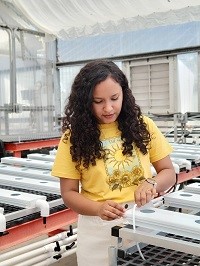 challenge faced by hydroponic growers using recirculating systems. Ozone and cold plasma technologies have been reported to aid in microbial sanitation and plant yield. However, it is important to consider and establish the correct method, dosage, and frequency of incorporating these technologies into hydroponic systems to avoid unwanted effect on plant growth or development. Through this project, we aim to study the physio-chemical properties of ozone and plasma-activated water and their effects on crop yield, sanitation, oxygen stability, and fertilizer interactions for hydroponic production.
challenge faced by hydroponic growers using recirculating systems. Ozone and cold plasma technologies have been reported to aid in microbial sanitation and plant yield. However, it is important to consider and establish the correct method, dosage, and frequency of incorporating these technologies into hydroponic systems to avoid unwanted effect on plant growth or development. Through this project, we aim to study the physio-chemical properties of ozone and plasma-activated water and their effects on crop yield, sanitation, oxygen stability, and fertilizer interactions for hydroponic production.
Last updated: 10 October 2023
Further information: Dr. Paul Fisher, University of Florida (pfisher@ufl.edu)
Greenhouse Sensors for Improved Climate Control
Daniel Crawford, M.S. student at The University of Florida
Daniel Crawford is researching climate sensors for propagation greenhouses. Production of seedlings, cuttings, and tissue culture transplants requires precise control of light, temperature, humidity, and mist irrigation. However, many greenhouses have few sensors inside their greenhouses and rely on a simple time clock and grower experience for mist timing. Commercially available sensors such as infra-red sensors for leaf temperature are being connected to a greenhouse control system at UF, to provide guidelines to growers on what sensors can be helpful. We are also helping commercial growers install sensors in mist zones. Climate data will also be used in a model of plant temperature and water loss to train growers on irrigation and climate control.
humidity, and mist irrigation. However, many greenhouses have few sensors inside their greenhouses and rely on a simple time clock and grower experience for mist timing. Commercially available sensors such as infra-red sensors for leaf temperature are being connected to a greenhouse control system at UF, to provide guidelines to growers on what sensors can be helpful. We are also helping commercial growers install sensors in mist zones. Climate data will also be used in a model of plant temperature and water loss to train growers on irrigation and climate control.
Last updated: 10 October 2023
Further information: Dr. Paul Fisher, University of Florida (pfisher@ufl.edu)
Exploring the Use of Calcium and Biological Control Agents (BCAs) as Alternative Management Strategies for Botrytis Blight.
Melissa Muñoz Agudelo, Ph.D. student at Clemson University
Botrytis cinerea is the fungal pathogen responsible for Botrytis blight in several crops including commercial cut roses. This disease is usually acquired during the production stage, but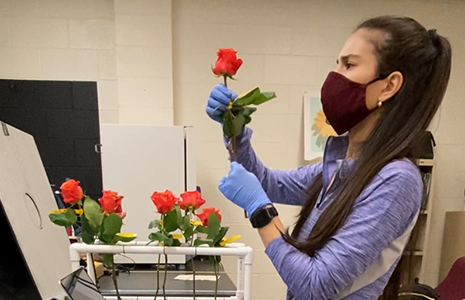 disease symptoms are more often seen in the post-harvest, especially when infected flowers are exposed to high humidity conditions during transportation. Fungicide applications as single-site or multisite products have been one of the main strategies for Botrytis blight management. However, during our previous research, we were able to prove that several B. cinerea isolates are resistant to different fungicide modes of action, which means a challenge for disease management, especially considering that environmental conditions in the commercial greenhouses like leaf wetness, temperature and relative humidity are favorable for disease development most of the time.
disease symptoms are more often seen in the post-harvest, especially when infected flowers are exposed to high humidity conditions during transportation. Fungicide applications as single-site or multisite products have been one of the main strategies for Botrytis blight management. However, during our previous research, we were able to prove that several B. cinerea isolates are resistant to different fungicide modes of action, which means a challenge for disease management, especially considering that environmental conditions in the commercial greenhouses like leaf wetness, temperature and relative humidity are favorable for disease development most of the time.
Current research focuses on the evaluation pre- and post-harvest applications of calcium in roses and assessment of different BCAs as management strategies for Botrytis blight alternative to the traditional fungicides. The integration of these strategies as part of integrated disease management might allow a better rotation of fungicides and hopefully reduce Botrytis blight incidence and severity.
Last updated: 21 May 2020
Further information: Melissa Muñoz and Dr. James Faust, Clemson University (munoz@clemson.edu, jfaust@clemson.edu)
Stock plant management techniques affect post-harvest flower development of Impatiens ×hybrida
Mary Vargo, M.S. Student at Clemson University
Mary Vargo is currently evaluating stock plant management techniques on the effects of post-harvest flower development of Impatiens xhybrida. One of the principle strategies for producing many cuttings from stock plants involves the weekly application of ethephon, however, high rates of ethephon can cause significant delays in flowering for cuttings grown in the post-harvest environment.
xhybrida. One of the principle strategies for producing many cuttings from stock plants involves the weekly application of ethephon, however, high rates of ethephon can cause significant delays in flowering for cuttings grown in the post-harvest environment.
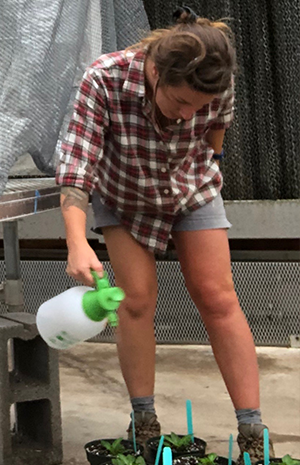 We are assisting stock plant growers by evaluating daily light integral levels, ethephon rates, and cutting harvest position on the stock plant to create guidelines for producing high-quality, uniform cuttings that flower in 5-6 weeks in the post-harvest production. We are also creating a bud meter that tracks flower development from visible bud to open flower at various temperatures so growers can utilize this resource as a means to keep the crop on schedule for the timely success of uniform flowering crops.
We are assisting stock plant growers by evaluating daily light integral levels, ethephon rates, and cutting harvest position on the stock plant to create guidelines for producing high-quality, uniform cuttings that flower in 5-6 weeks in the post-harvest production. We are also creating a bud meter that tracks flower development from visible bud to open flower at various temperatures so growers can utilize this resource as a means to keep the crop on schedule for the timely success of uniform flowering crops.
Last updated: 21 May 2020
Further information: Mary Vargo and Dr. Jim Faust, Clemson University (mavargo@g.clemson.edu, jfaust@clemson.edu)

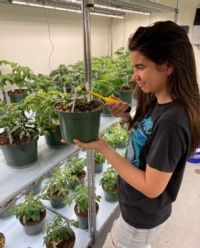 increasing number of compact fruiting vegetables are becoming available for home gardening, which has been ranked as one of the fastest-growing trends in horticulture. However, evaluations are limited, especially under the reduced light intensity and different light spectra with sole-source lighting compared to sunlight. Her research is focused on identifying resilient cultivars that are compact and high-yielding, are not susceptible to physiological disorders commonly observed indoors, and can thrive with minimal inputs in order to ensure consumer success.
increasing number of compact fruiting vegetables are becoming available for home gardening, which has been ranked as one of the fastest-growing trends in horticulture. However, evaluations are limited, especially under the reduced light intensity and different light spectra with sole-source lighting compared to sunlight. Her research is focused on identifying resilient cultivars that are compact and high-yielding, are not susceptible to physiological disorders commonly observed indoors, and can thrive with minimal inputs in order to ensure consumer success. problem affecting cut rose production in both pre- and post-harvest conditions which leads to losses for both growers and wholesalers. One of the principal strategies for disease management is fungicide applications including multisite and site-specific fungicides. However, the development of resistance is becoming more problematic especially in the case of the site-specific fungicides, making them less effective.
problem affecting cut rose production in both pre- and post-harvest conditions which leads to losses for both growers and wholesalers. One of the principal strategies for disease management is fungicide applications including multisite and site-specific fungicides. However, the development of resistance is becoming more problematic especially in the case of the site-specific fungicides, making them less effective.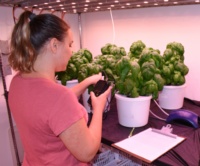 for urban homeowners and is an expanding market to sell transplants and growing systems. However, nutrient and pH management are too complex for most consumers. Nowadays, new CRF materials are available in the US. In this project, Dr. Fisher and Fernanda aim to simplify nutrient management in hydroponics by formulating a standard dose of blended CRF per gallon per month. This would improve consumer success with ‘grow your own’ vegetables.
for urban homeowners and is an expanding market to sell transplants and growing systems. However, nutrient and pH management are too complex for most consumers. Nowadays, new CRF materials are available in the US. In this project, Dr. Fisher and Fernanda aim to simplify nutrient management in hydroponics by formulating a standard dose of blended CRF per gallon per month. This would improve consumer success with ‘grow your own’ vegetables.  growers have reduced the amount of fertilizer applied to their spring bedding plant crops. This has resulted in concern about the performance of these plants once the consumer has purchased them. This experiment was designed to determine the effect of different fertilizer delivery methods and fertilizer concentrations on the growth of petunias (Petunia x hybrida) in the consumer environment. We focused on three fertilizer delivery strategies: Constant Liquid Fertilization Program, Controlled Release Fertilization Program and Post-Production Fertilizer Pulse Treatment. This study also examines the fertilizer cost efficacy associated with different fertilizer application techniques.
growers have reduced the amount of fertilizer applied to their spring bedding plant crops. This has resulted in concern about the performance of these plants once the consumer has purchased them. This experiment was designed to determine the effect of different fertilizer delivery methods and fertilizer concentrations on the growth of petunias (Petunia x hybrida) in the consumer environment. We focused on three fertilizer delivery strategies: Constant Liquid Fertilization Program, Controlled Release Fertilization Program and Post-Production Fertilizer Pulse Treatment. This study also examines the fertilizer cost efficacy associated with different fertilizer application techniques. flowering plants from the greenhouse to retail locations. This phenomenon is a result of Botrytis infection in the greenhouse, and the disease expression occurs when the plants are placed in a humid environment during transport. We are looking at alternative compounds for control as fungicides are becoming less effective due to resistance development. Initial studies demonstrated the potential value of calcium to inhibit Botrytis infection in petunia flowers. So, we are conducting experiments to determine the best strategies for applying calcium to reduce the postharvest losses that occur due to Botrytis infection.
flowering plants from the greenhouse to retail locations. This phenomenon is a result of Botrytis infection in the greenhouse, and the disease expression occurs when the plants are placed in a humid environment during transport. We are looking at alternative compounds for control as fungicides are becoming less effective due to resistance development. Initial studies demonstrated the potential value of calcium to inhibit Botrytis infection in petunia flowers. So, we are conducting experiments to determine the best strategies for applying calcium to reduce the postharvest losses that occur due to Botrytis infection.
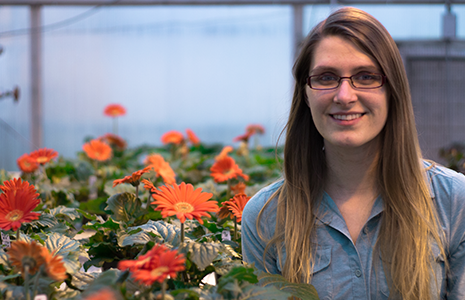 short wavelength radiation, carbon dioxide, and temperature interact and influence leafy green and herb flavor, volatile oil content, anthocyanins, growth, and development. Additionally, she has several side projects that include 1) quantifying the impact of carrier water alkalinity and air temperature at application on the efficacy of various plant growth regulators (PGRs) including ethephon and 2) determining the photoperiodic flowering responses of several specialty crops.
short wavelength radiation, carbon dioxide, and temperature interact and influence leafy green and herb flavor, volatile oil content, anthocyanins, growth, and development. Additionally, she has several side projects that include 1) quantifying the impact of carrier water alkalinity and air temperature at application on the efficacy of various plant growth regulators (PGRs) including ethephon and 2) determining the photoperiodic flowering responses of several specialty crops.